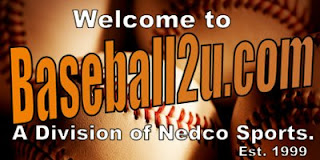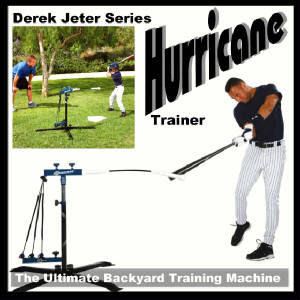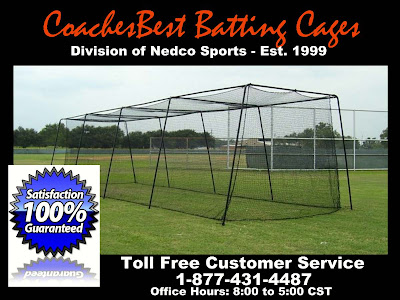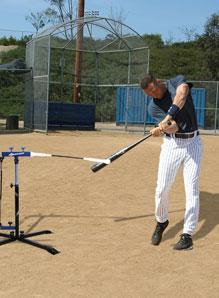
Baseball2u.com
By Nick Dixon
There is nothing more beautiful in sports than when a "major league" swing whether it be at the tee ball, little league, high school, college or Major League Baseball level of play. A "major league" swing is what I consider to be a perfectly executed swing. There is nothing more beautiful in sports than when you see a baseball batter, at any level, executes the perfect swing, and drive a line drive into one of the outfield gaps.
What makes a little league baseball swing become a "major league" swing? What are the 5 elements of the perfect baseball swing? The answer to that question is simple. The batter must have batting skill, good bat speed, a good eye for the baseball, perfect timing and a proper approach to hitting. Here I discuss all five of these basic elements and how each is improved:
The five basic elements of the "Major League" Little League Swing are:
1. Batting Skill - There is only one way to improve batting skill. That is making sure that the batter takes a high number of practice swings daily or at least 3 times a week year round. The younger the batter begins this practice routine, the batter. It is crucial to batting skill development that the batter receives proper instruction as to proper hitting mechanics.
2. Bat Speed - The grip must be perfect with the fingers aligned and the bat handle gripped in the fingers and not deep in the palm. The batter must have adequate strength to get the bat speed generated. The absolute best way to improve hand and arm strength is do finger pushups, weight roll ups with the arms extended and wrist curls with the arms on a bench.
3. Good Eye for the Ball - There are two things involved in having a good batting eye at the plate. First the batter must learn the strike zone and be able to determine quickly whether a pitch is a in the strike zone or out of it. The other thing that makes the eyes of the batter an asset at the plate, is when the batter has the ability to pitch the ball up very quickly as it is released from the hand of the pitcher. The batter must learn to identify pitches, the spin on the ball, the pitchers arm slot, and the pitchers release point. There are many drills that can help a better have a better eye. One such drill is a "tracking" drill in which the batter stands in while a pitcher throws his bull pen. The batter verbally calls out the type of pitch and its location. The batter will call the pitch in this order...strike, fastball, in or ball, curve ball, off the plate away.
4. Proper Timing - Good timing is something that all great hitters possess. They know when to load and when to launch. They are never late on the fastball. They are never early on the off speed pitch. They know exactly when to attack the pitch based on where the pitch is located. The always attack the inside fastball early. They always attack the fastball down the middle when it gets over the plate. And most important of all, they attack the off-speed pitch late when it gets just inside the back foot. One of the best drills to develop timing is the do a front long toss drill. The pitcher should vary locations, speed and pitch types.
5. Proper Approach - Having a good approach at the plate is a process that involves two aspects of mental concentration.
One part of having an approach is to know what your team needs from your at bat.This is known before the batter walks up to the plate. For example, if the team needs a deep fly ball, the batter looks for a pitch up. If the team needs a ball hit behind a runner, the batter will look for a pitch to hit the other way.
The other part of having an approach is the batter executing the perfect timed swing for the pitch thrown. The batter turns on the fastball in or the batter stays back and hits the curve ball to the opposite field.
The best way to develop a good approach at the plate is to have situational batting practice sessions. The batter takes batting practice swings under simulated situations specified by the coach. The batter practices hitting with the coach calling different numbers of out, different base runner locations or different offensive plays be run.
I hope that you found this article to be interesting and informative. I really appreciate you taking the time to read it. Have a great day. Nick
The CoachesBest Baseball Store has a great selection of 1400 Baseball Products. Check out the BatAction Hitting Machine baseball pitching simulator. This high speed training machine is 100% Guaranteed to raise Batting Averages and has a full year warranty.
Nick Dixon is the President and founder of Nedco Sports, a sports training company established in 1999. Dixon is also an active and full time high school baseball coach with over 25 years experience. Coach Dixon is better known as the inventor of the BatAction Hitting Machine, the SKLZ Derek Jeter Hurricane Hitting Machine, the SKLZ Target Trainer, the SKLZ Derek Jeter ZipnHit Pro, and the SKLZ Strikeback Trainer. Dixon is also a contributing writer for BaseballCoachingDigest, the Youth Baseball Digest, the Baseball Parent Guide, the Baseball 2Day Coaches Journal, and Blog4Coaches.
Article Source: http://EzineArticles.com/?expert=Nick_Dixon
===Advertisement from our sponsor:=====

Baseball2u.com/CoachesBest.com is the ultimate online baseball training and coaching store. With over 1400 products organized into categories Baseball2u.com makes finding that baseball training product easy and simple. Order securely online or by phone. Baseball2u.com is a fully licensed company and has a full time staff available from 8:00 to 5:00 CST. Their toll free customer service number is 1-877-431-4487.
The Categories they have are: Baseball Training Equipment, Youth Baseball Training Equipment, Training Bats, Pitching & Throwing Trainers, Defensive Trainers, Batting Cages, Pitching Machines, Jugs Equipment, Game and Practice Baseballs, Protective Practice Screens and Nets, Portable Pitching Mounds, Baseball DVDs & Books, Clearance Items on Sales, BatAction Hitting Machines, Hurricane Hitting Machines, NEDCO Bataction Replacement Parts, SKLZ Hurricane Replacement Parts and Much Much More! Visit Baseball2U.com today!











